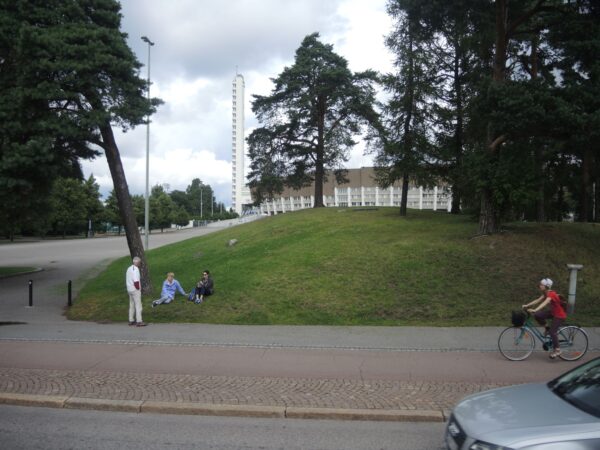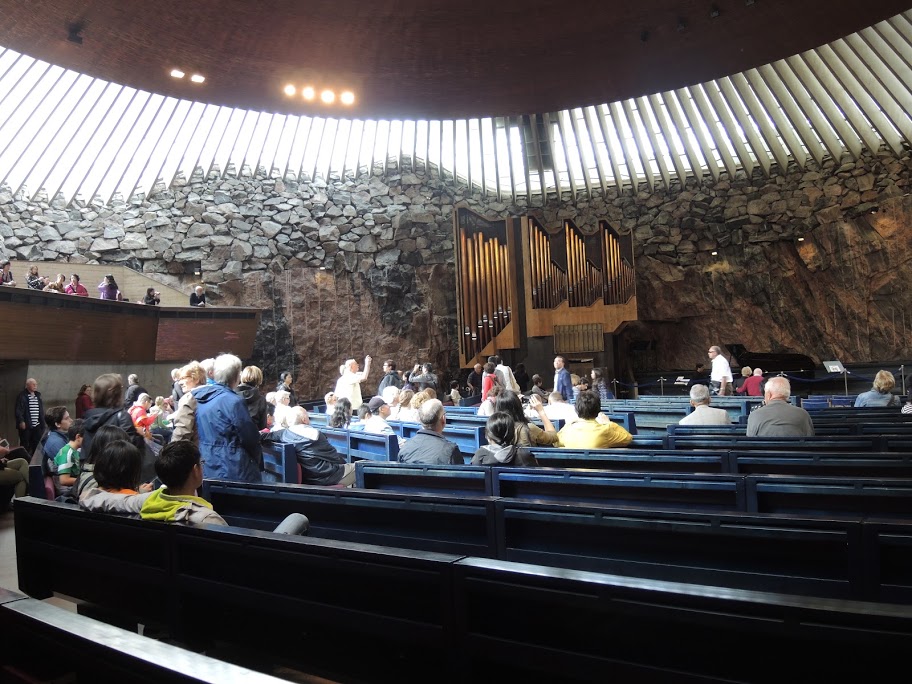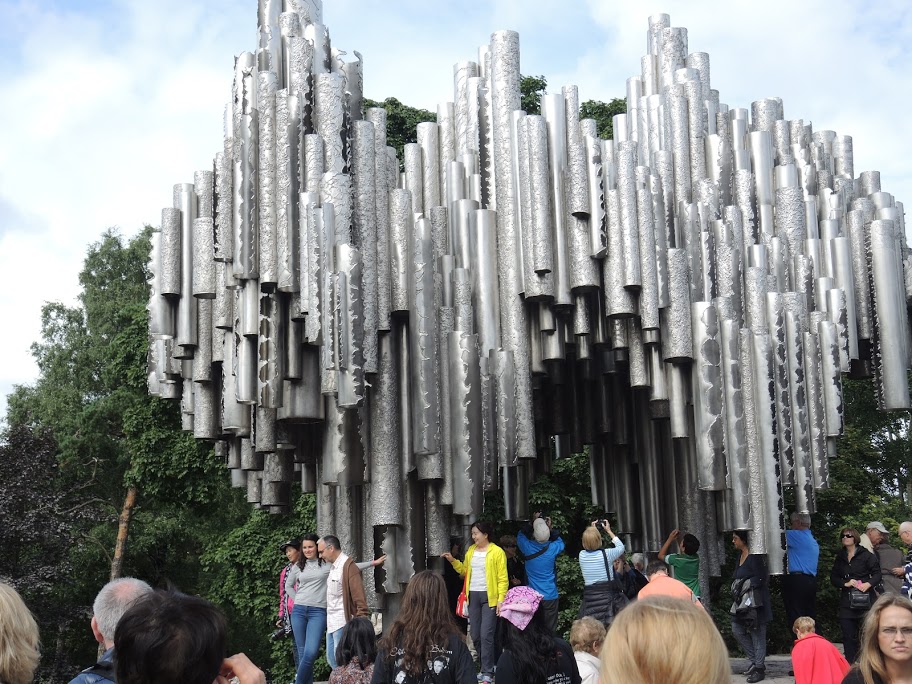Since I (rather foolishly) wasn’t spending the night in Helsinki, I was able to leave my overnight gear in my cabin on the ferry. This certainly made it easy for Frederick to guide the few of us who’d grafted this extension onto the main trip directly into the waiting van where we’d begin a three-hour ride around the city.
Our first stop was at the renowned Temppeliaukio Church colloquially referred to as the Rock Church. The church was completed in 1969 and designed by the architect brothers Tuomo and Timo Suomalainen who, it is said, drew their inspiration from the shape of Helsinki’s archipelago.
While it’s necessary to see some churches because of their architectural or historic importance (that sometimes extends to art and literature as well), I generally avoid the ABC (another bloody church) aspect of many guided city tours. Temppeliaukio Church is a worthwhile exception.
The church is blasted out of solid granite, has a rather unassuming entrance, and gives the feeling of being mostly underground. However, the design allows it to be suffused by natural light through a 360-degree skylight encircling the upper reaches of the structure. The excellence of the acoustics provided by the wound copper wire ceiling and exposed granite walls became immediately evident when we entered the building and heard the piano soloist playing just in front and to the right of the altar and organ.
The church has no bells instead using a recording of bells composed by the late Finnish composer Taneli Kuusisto. The pipe organ visible in the photo was manufactured by another Finn, Veikko Virtanen and has 43 stops and 3001 pipes.
As we proceed to our next stop, we have to remember that Finland is a relatively young country and that, in combination with a certain American provincialism (of which I am also guilty) makes the list of famous Finns (at least the ones Americans would recognize) undoubtedly a short one. One of those names, however, should be that of the composer Jean Sibelius.
Sibelius is certainly recognized as the most important Finnish composer and most consider him the national composer of Finland. In addition to his seven symphonies, the symphonic poem Finlandia which is said to evoke the national struggle of the Finnish people stands among the composer’s most well-known works.
Sibelius also drew inspiration from nature and Nordic mythology delving deeply into the heroic legends of the national epic, the Kalevala.
This epic poem draws on Finnish and Karelian folklore and mythology for its 50 songs and nearly 23,000 verses. The source material was compiled by Elias Lonnrot and he published the final version in 1845. The Kalevala, because of its role in strengthening the sense of Finnish nationality, likely holds an even deeper resonance in the hearts of Finns than the Iliad, the Nibelungenlied, or Beowulf do for the Greeks, the Germans, or the English.
The Sibelius monument by the Finnish artist Eila Hiltunen was unveiled in Helsinki on a day with some personal meaning to me, 7 September 1967. According to our guide, as a piece of abstract art, it (unsurprisingly) engendered some controversy and debate. (Here, again, are the morning’s photos.)
The artist hoped to capture the essence of the composer’s music and she individually shaped and welded each of the more than 600 individual steel pipes that comprise the main part of the monument. One intent of the design was to allow visitors to interact with the memorial not only visually – as you can see in the photo above – but also auditorily by creating their own sounds and echoes within the structure.
Somewhat sadly and predictably, this concept and her effort didn’t satisfy everyone. Those who had a more limited and provincial concept of such a memorial were able to force the inclusion of a steel effigy of Sibelius that sits to the right of this photo and accompanies the main monument.
(Americans might remember a similar controversy roiling around the Vietnam Veterans Memorial. Critics attacked its black color – {war memorials should be white}, its placement {sunk into the ground somehow suggested shame to them}, and its design {it looked like a wound and had neither an American Flag nor a heroic structure}. The last two elements were added two years after its initial dedication in 1982. As at the Vietnam Memorial where people are drawn to Maya Lin’s design and largely ignore the needless addition, most of the visitors I saw paid little attention to the Sibelius statue.)
As our tour wound down, we rode past the 1952 Olympic Stadium – a prominent example of architectural functionalism and that we glimpsed as our van passed.

The stadium was originally built in anticipation of Helsinki hosting the 1940 Summer Olympics but the Winter War and World War II intervened. There were also no Olympic Games in 1944 and the first post war Games were granted to London. The Finns finally had the chance to use their Olympic facilities in 1952 and these were the first games in which Germany, Japan, China, the Soviet Union, and Israel all took part as independent nations.
Here are two interesting Olympic sidebar notes. Although the only capital of an independent country farther north than Helsinki is Reykjavík, Iceland, Finland has hosted a Summer Olympics but never a Winter Olympic Games. The simple reason for this is that the country lacked accessible mountains to accommodate the downhill events.
The other fun fact is that one of the great middle – and long-distance runners in the history of the sport is another person on that short list of Finnish names recognizable certainly to sports minded Americans – Paavo Nurmi nicknamed the “Flying Finn.” Nurmi, who won nine Olympic gold medals, also set 22 world records at distances ranging from 1,500 meters to 20 kilometers.
As I noted above, the bus tour wound down and ended in Senate Square. At this time, watching the clouds that had been slowly gathering all morning continue to condense as though to discuss some aqueous secret, I took my leave from those who were staying on in Finland or in the group that was going on to Saint Petersburg. This included the Australians Frank and Heidy, Florida attorney Phil, and the Minnesotans John and Mary.
With only a few hours available until I had to return to the ferry and begin the journey home, I would soon set off on my afternoon walk through Helsinki. And that will be the subject of my next, and final, posts for my Scottish, Scandinavian, and Nordic adventure of 2015.

